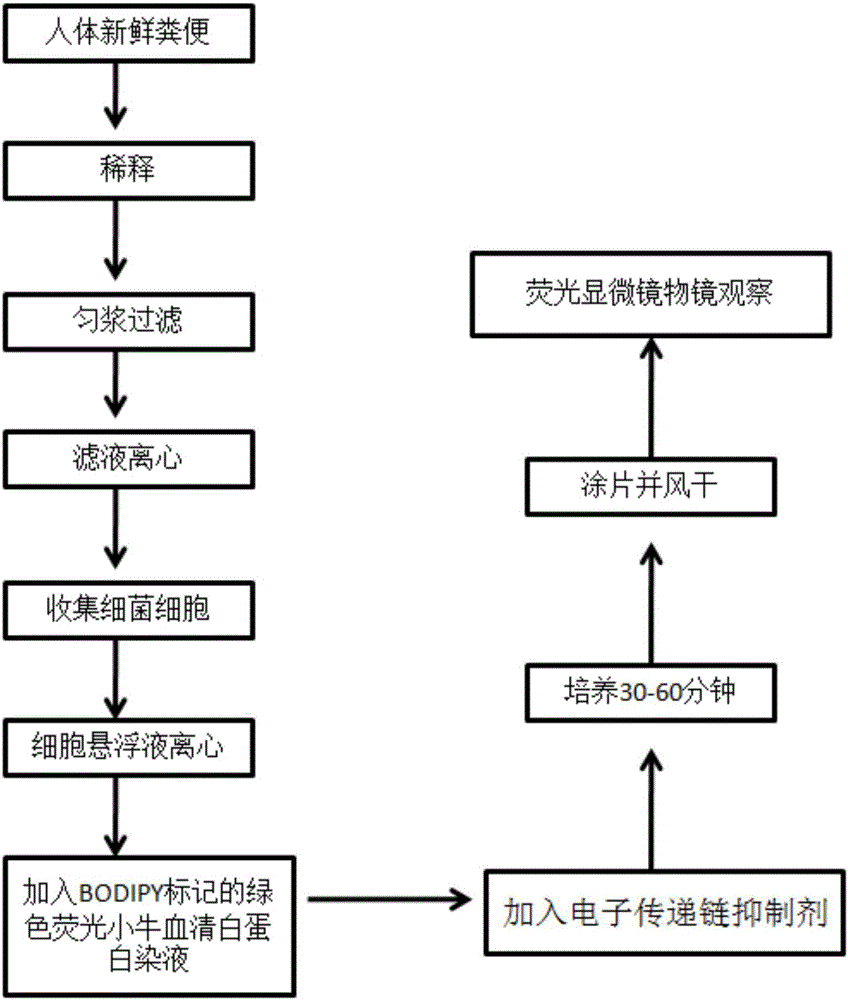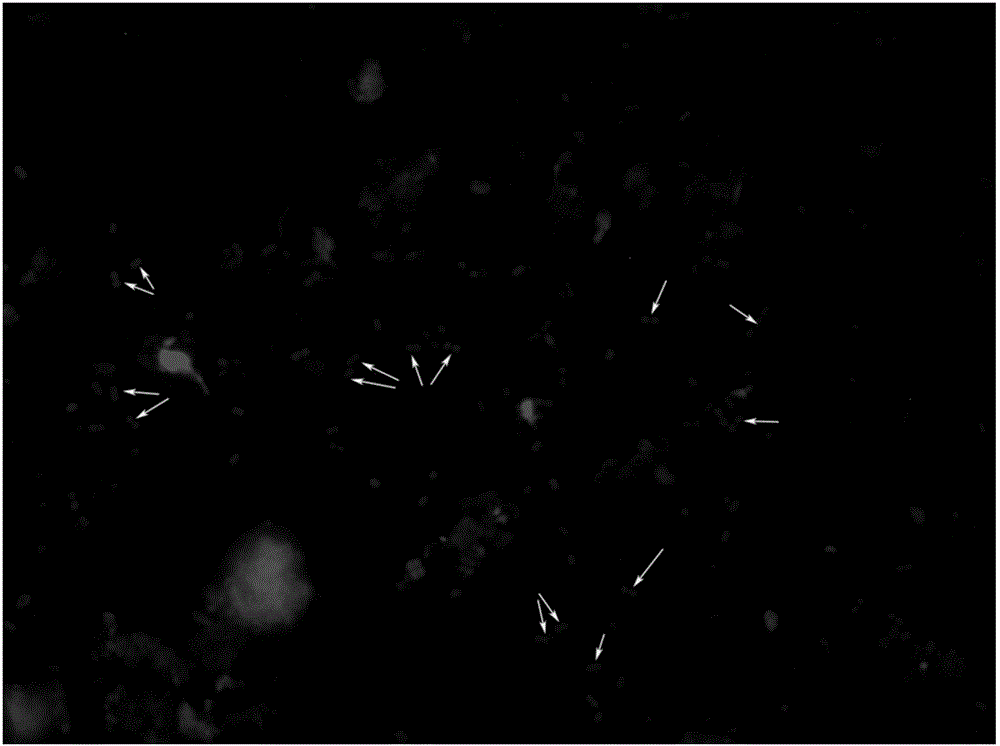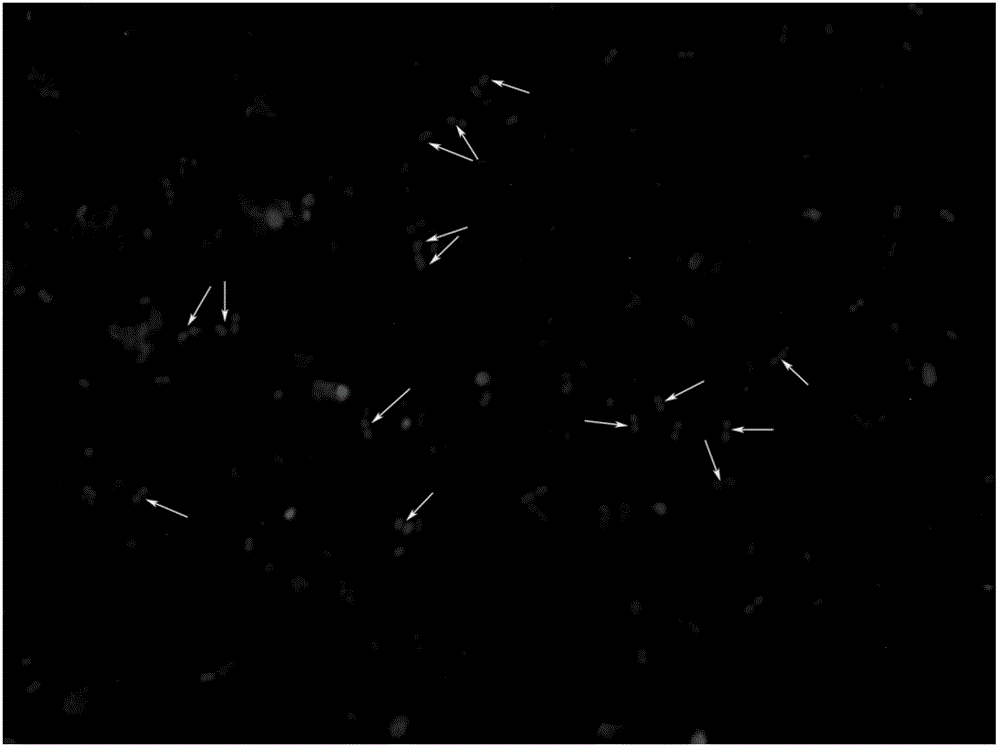Method for rapidly detecting proteolysis bacteria in human excrement
A technology for protein hydrolysis and detection of human body, which is applied in the direction of biochemical equipment and methods, microbial measurement/inspection, etc., to achieve the effect of simple operation process, cost reduction, and easy operation
- Summary
- Abstract
- Description
- Claims
- Application Information
AI Technical Summary
Problems solved by technology
Method used
Image
Examples
Embodiment 1
[0045] A method for quickly detecting proteolytic bacteria in human feces, the process is as follows figure 1 As shown, including the following steps:
[0046] Step (1), collect total bacteria in feces under aseptic conditions:
[0047] (1.1) Sample collection: Use a sterile medicine spoon to randomly collect fresh human feces in a sterile bag, immediately store them in an incubator at 37°C, and send them to the laboratory for processing within 20 minutes;
[0048] (1.2) Dilute the sample: Take 10g of fresh stool, add it to 1×PBS buffer at pH 7.0, and mix well; the mass-volume ratio of the fresh stool to 1×PBS buffer W / V=0.95:3.5;
[0049] (1.3) Homogenization filtration: transfer the homogenized liquid in step (1.2) into a Bio-Rad homogenization bag, then place it in a Bio-Rad homogenizer and homogenize at 5000 R.PM for 8 minutes. After homogenization, The liquid in the homogenization bag is filtered through the filter grid on the side of the homogenization bag, and the filtrate is ...
Embodiment 2
[0060] A method for rapidly detecting proteolytic bacteria in human feces, including the following steps:
[0061] Step (1), collect total bacteria in feces under aseptic conditions:
[0062] (1.1) Sample collection: Use a sterile medicine spoon to randomly collect fresh human feces in a sterile bag, immediately store them in an incubator at 37°C, and send them to the laboratory for processing within 20 minutes;
[0063] (1.2) Dilute the sample: Take 20 g of fresh stool, add it to 1×PBS buffer at pH 8.0, and mix well; the mass-volume ratio of the fresh stool to 1×PBS buffer W / V=1.05:3.5;
[0064] (1.3) Homogenization filtration: transfer the homogenized liquid in step (1.2) into a Bio-Rad homogenization bag, and then place it in a Bio-Rad homogenizer to homogenize at 10000 R.PM for 15 min. After homogenization, Filter the liquid in the homogenization bag through the filter grid on the side of the homogenization bag, and take the filtrate;
[0065] (1.4) Centrifugation of the filtrate: ...
Embodiment 3
[0075] A method for rapidly detecting proteolytic bacteria in human feces, including the following steps:
[0076] Step (1), collect total bacteria in feces under aseptic conditions:
[0077] (1.1) Sample collection: Use a sterile medicine spoon to randomly collect fresh human feces in a sterile bag, immediately store them in an incubator at 37°C, and send them to the laboratory for processing within 20 minutes;
[0078] (1.2) Dilute the sample: Take 15g of fresh stool, add it to 1×PBS buffer at pH 7.5, and mix well; the mass-volume ratio of the fresh stool to 1×PBS buffer W / V=1:3.5;
[0079] (1.3) Homogenization filtration: transfer the homogenized liquid in step (1.2) to a Bio-Rad homogenization bag, and then place it in a Bio-Rad homogenizer to homogenize at 8000 R.PM for 10 minutes. After homogenization, The liquid in the homogenization bag is filtered through the filter grid on the side of the homogenization bag, and the filtrate is taken;
[0080] (1.4) Centrifugation of filtrate...
PUM
 Login to View More
Login to View More Abstract
Description
Claims
Application Information
 Login to View More
Login to View More - R&D
- Intellectual Property
- Life Sciences
- Materials
- Tech Scout
- Unparalleled Data Quality
- Higher Quality Content
- 60% Fewer Hallucinations
Browse by: Latest US Patents, China's latest patents, Technical Efficacy Thesaurus, Application Domain, Technology Topic, Popular Technical Reports.
© 2025 PatSnap. All rights reserved.Legal|Privacy policy|Modern Slavery Act Transparency Statement|Sitemap|About US| Contact US: help@patsnap.com



